Entrepreneurial Development: Recycling Business Proposal in UK
VerifiedAdded on 2023/05/28
|22
|5973
|419
Report
AI Summary
This report outlines an entrepreneurial development proposal centered around a recycling business model within the UK's apparel and footwear market. The proposal addresses socio-economic problems like water consumption and textile waste by focusing on recycling waste garments to create new fabrics. It employs Simon Sinek's Golden Circle Theory to define its value proposition, emphasizing sustainability and environmental responsibility as core aims. The business idea involves a private limited company seeking investment to implement a recycling strategy that reduces water consumption and pollution. The report details opportunity formation, key resources, potential partners (including government, retailers, and technology providers), and key activities necessary for the venture. It further explores opportunity development, including audience segmentation, relationship management, and distribution channels. Finally, the report presents an estimation of costs, revenue streams, and the overall cost structure, concluding with the potential for positive social and environmental impact.
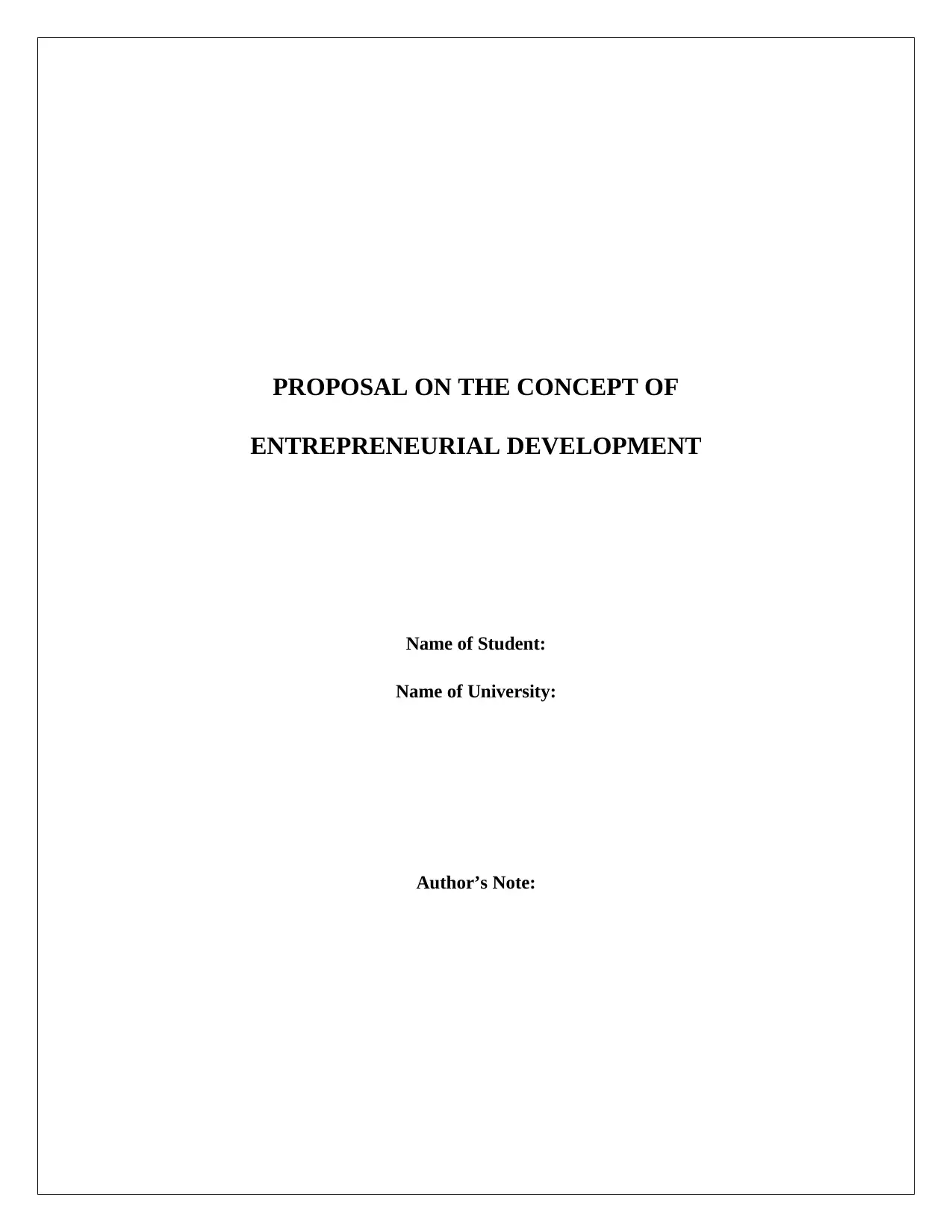
PROPOSAL ON THE CONCEPT OF
ENTREPRENEURIAL DEVELOPMENT
Name of Student:
Name of University:
Author’s Note:
ENTREPRENEURIAL DEVELOPMENT
Name of Student:
Name of University:
Author’s Note:
Paraphrase This Document
Need a fresh take? Get an instant paraphrase of this document with our AI Paraphraser
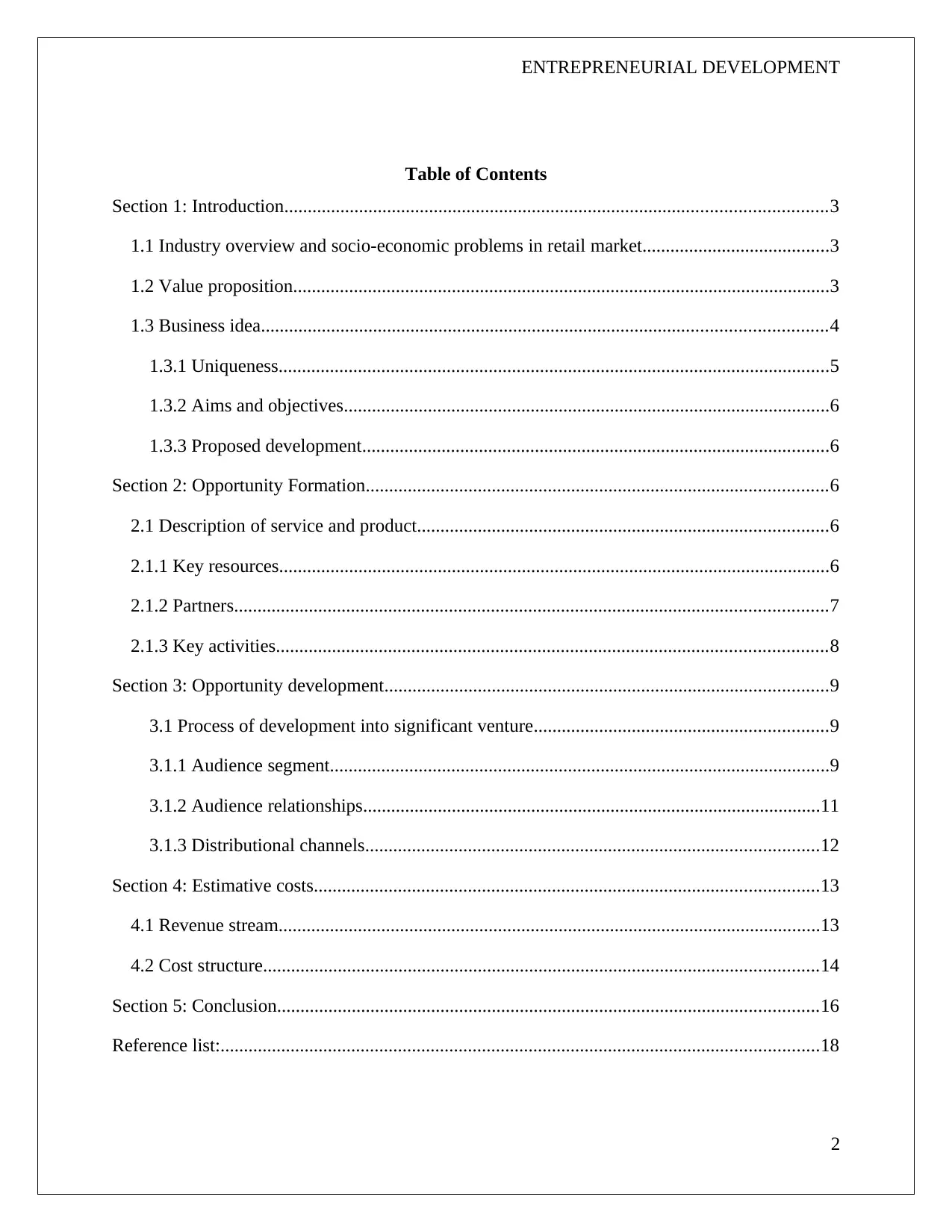
ENTREPRENEURIAL DEVELOPMENT
Table of Contents
Section 1: Introduction....................................................................................................................3
1.1 Industry overview and socio-economic problems in retail market........................................3
1.2 Value proposition...................................................................................................................3
1.3 Business idea.........................................................................................................................4
1.3.1 Uniqueness......................................................................................................................5
1.3.2 Aims and objectives........................................................................................................6
1.3.3 Proposed development....................................................................................................6
Section 2: Opportunity Formation...................................................................................................6
2.1 Description of service and product........................................................................................6
2.1.1 Key resources......................................................................................................................6
2.1.2 Partners...............................................................................................................................7
2.1.3 Key activities......................................................................................................................8
Section 3: Opportunity development...............................................................................................9
3.1 Process of development into significant venture...............................................................9
3.1.1 Audience segment...........................................................................................................9
3.1.2 Audience relationships..................................................................................................11
3.1.3 Distributional channels.................................................................................................12
Section 4: Estimative costs............................................................................................................13
4.1 Revenue stream....................................................................................................................13
4.2 Cost structure.......................................................................................................................14
Section 5: Conclusion....................................................................................................................16
Reference list:................................................................................................................................18
2
Table of Contents
Section 1: Introduction....................................................................................................................3
1.1 Industry overview and socio-economic problems in retail market........................................3
1.2 Value proposition...................................................................................................................3
1.3 Business idea.........................................................................................................................4
1.3.1 Uniqueness......................................................................................................................5
1.3.2 Aims and objectives........................................................................................................6
1.3.3 Proposed development....................................................................................................6
Section 2: Opportunity Formation...................................................................................................6
2.1 Description of service and product........................................................................................6
2.1.1 Key resources......................................................................................................................6
2.1.2 Partners...............................................................................................................................7
2.1.3 Key activities......................................................................................................................8
Section 3: Opportunity development...............................................................................................9
3.1 Process of development into significant venture...............................................................9
3.1.1 Audience segment...........................................................................................................9
3.1.2 Audience relationships..................................................................................................11
3.1.3 Distributional channels.................................................................................................12
Section 4: Estimative costs............................................................................................................13
4.1 Revenue stream....................................................................................................................13
4.2 Cost structure.......................................................................................................................14
Section 5: Conclusion....................................................................................................................16
Reference list:................................................................................................................................18
2
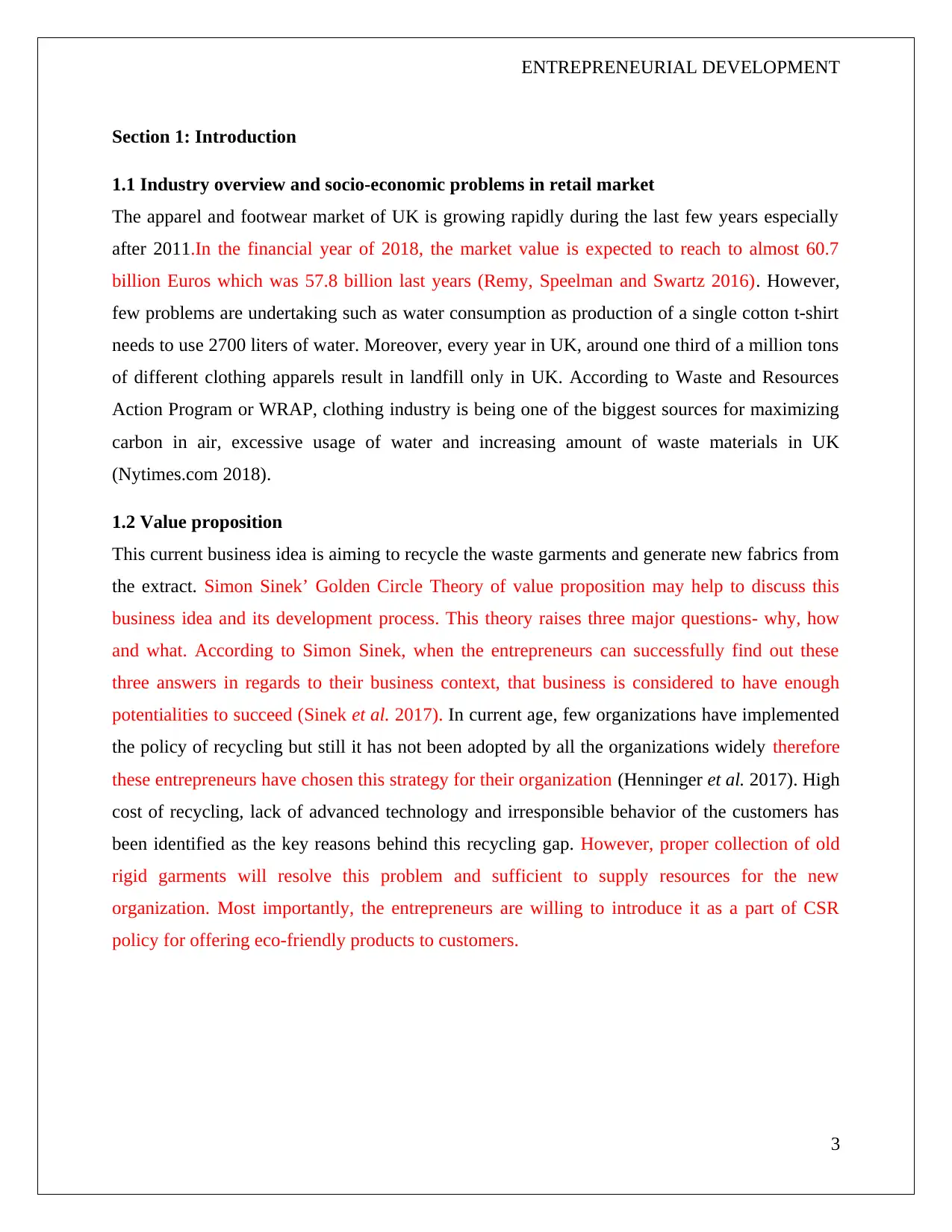
ENTREPRENEURIAL DEVELOPMENT
Section 1: Introduction
1.1 Industry overview and socio-economic problems in retail market
The apparel and footwear market of UK is growing rapidly during the last few years especially
after 2011.In the financial year of 2018, the market value is expected to reach to almost 60.7
billion Euros which was 57.8 billion last years (Remy, Speelman and Swartz 2016). However,
few problems are undertaking such as water consumption as production of a single cotton t-shirt
needs to use 2700 liters of water. Moreover, every year in UK, around one third of a million tons
of different clothing apparels result in landfill only in UK. According to Waste and Resources
Action Program or WRAP, clothing industry is being one of the biggest sources for maximizing
carbon in air, excessive usage of water and increasing amount of waste materials in UK
(Nytimes.com 2018).
1.2 Value proposition
This current business idea is aiming to recycle the waste garments and generate new fabrics from
the extract. Simon Sinek’ Golden Circle Theory of value proposition may help to discuss this
business idea and its development process. This theory raises three major questions- why, how
and what. According to Simon Sinek, when the entrepreneurs can successfully find out these
three answers in regards to their business context, that business is considered to have enough
potentialities to succeed (Sinek et al. 2017). In current age, few organizations have implemented
the policy of recycling but still it has not been adopted by all the organizations widely therefore
these entrepreneurs have chosen this strategy for their organization (Henninger et al. 2017). High
cost of recycling, lack of advanced technology and irresponsible behavior of the customers has
been identified as the key reasons behind this recycling gap. However, proper collection of old
rigid garments will resolve this problem and sufficient to supply resources for the new
organization. Most importantly, the entrepreneurs are willing to introduce it as a part of CSR
policy for offering eco-friendly products to customers.
3
Section 1: Introduction
1.1 Industry overview and socio-economic problems in retail market
The apparel and footwear market of UK is growing rapidly during the last few years especially
after 2011.In the financial year of 2018, the market value is expected to reach to almost 60.7
billion Euros which was 57.8 billion last years (Remy, Speelman and Swartz 2016). However,
few problems are undertaking such as water consumption as production of a single cotton t-shirt
needs to use 2700 liters of water. Moreover, every year in UK, around one third of a million tons
of different clothing apparels result in landfill only in UK. According to Waste and Resources
Action Program or WRAP, clothing industry is being one of the biggest sources for maximizing
carbon in air, excessive usage of water and increasing amount of waste materials in UK
(Nytimes.com 2018).
1.2 Value proposition
This current business idea is aiming to recycle the waste garments and generate new fabrics from
the extract. Simon Sinek’ Golden Circle Theory of value proposition may help to discuss this
business idea and its development process. This theory raises three major questions- why, how
and what. According to Simon Sinek, when the entrepreneurs can successfully find out these
three answers in regards to their business context, that business is considered to have enough
potentialities to succeed (Sinek et al. 2017). In current age, few organizations have implemented
the policy of recycling but still it has not been adopted by all the organizations widely therefore
these entrepreneurs have chosen this strategy for their organization (Henninger et al. 2017). High
cost of recycling, lack of advanced technology and irresponsible behavior of the customers has
been identified as the key reasons behind this recycling gap. However, proper collection of old
rigid garments will resolve this problem and sufficient to supply resources for the new
organization. Most importantly, the entrepreneurs are willing to introduce it as a part of CSR
policy for offering eco-friendly products to customers.
3
⊘ This is a preview!⊘
Do you want full access?
Subscribe today to unlock all pages.

Trusted by 1+ million students worldwide
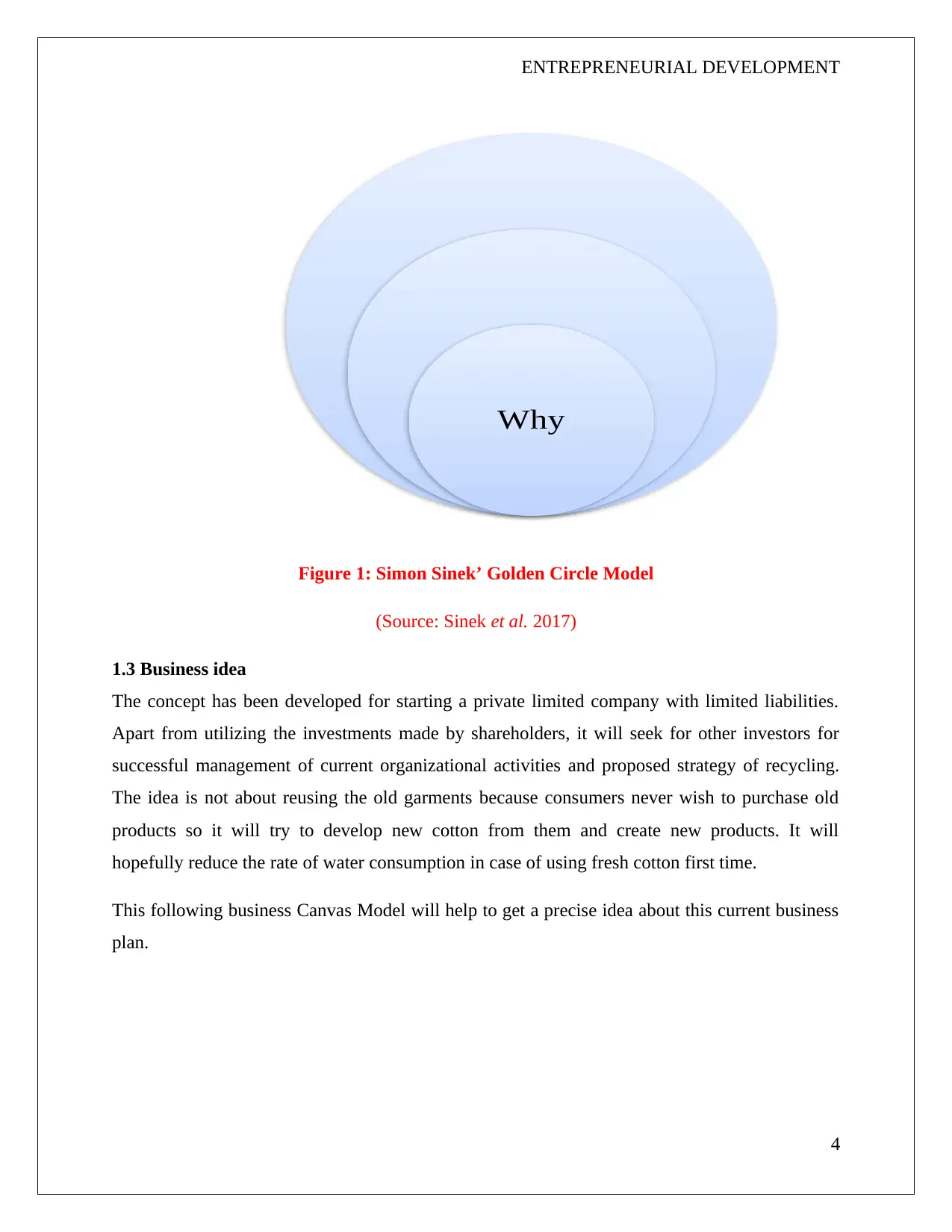
ENTREPRENEURIAL DEVELOPMENT
Figure 1: Simon Sinek’ Golden Circle Model
(Source: Sinek et al. 2017)
1.3 Business idea
The concept has been developed for starting a private limited company with limited liabilities.
Apart from utilizing the investments made by shareholders, it will seek for other investors for
successful management of current organizational activities and proposed strategy of recycling.
The idea is not about reusing the old garments because consumers never wish to purchase old
products so it will try to develop new cotton from them and create new products. It will
hopefully reduce the rate of water consumption in case of using fresh cotton first time.
This following business Canvas Model will help to get a precise idea about this current business
plan.
4
What
How
Why
Figure 1: Simon Sinek’ Golden Circle Model
(Source: Sinek et al. 2017)
1.3 Business idea
The concept has been developed for starting a private limited company with limited liabilities.
Apart from utilizing the investments made by shareholders, it will seek for other investors for
successful management of current organizational activities and proposed strategy of recycling.
The idea is not about reusing the old garments because consumers never wish to purchase old
products so it will try to develop new cotton from them and create new products. It will
hopefully reduce the rate of water consumption in case of using fresh cotton first time.
This following business Canvas Model will help to get a precise idea about this current business
plan.
4
What
How
Why
Paraphrase This Document
Need a fresh take? Get an instant paraphrase of this document with our AI Paraphraser
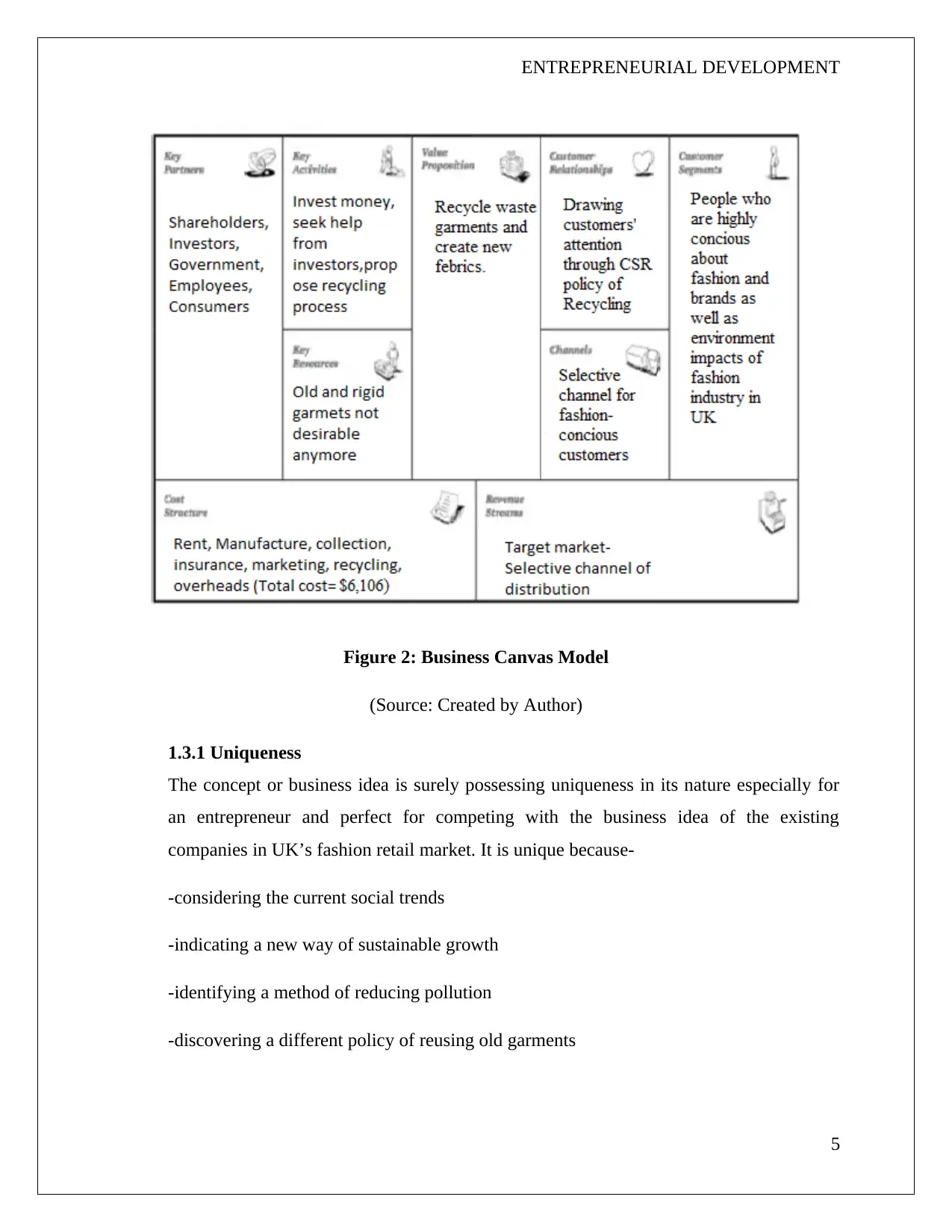
ENTREPRENEURIAL DEVELOPMENT
Figure 2: Business Canvas Model
(Source: Created by Author)
1.3.1 Uniqueness
The concept or business idea is surely possessing uniqueness in its nature especially for
an entrepreneur and perfect for competing with the business idea of the existing
companies in UK’s fashion retail market. It is unique because-
-considering the current social trends
-indicating a new way of sustainable growth
-identifying a method of reducing pollution
-discovering a different policy of reusing old garments
5
Figure 2: Business Canvas Model
(Source: Created by Author)
1.3.1 Uniqueness
The concept or business idea is surely possessing uniqueness in its nature especially for
an entrepreneur and perfect for competing with the business idea of the existing
companies in UK’s fashion retail market. It is unique because-
-considering the current social trends
-indicating a new way of sustainable growth
-identifying a method of reducing pollution
-discovering a different policy of reusing old garments
5
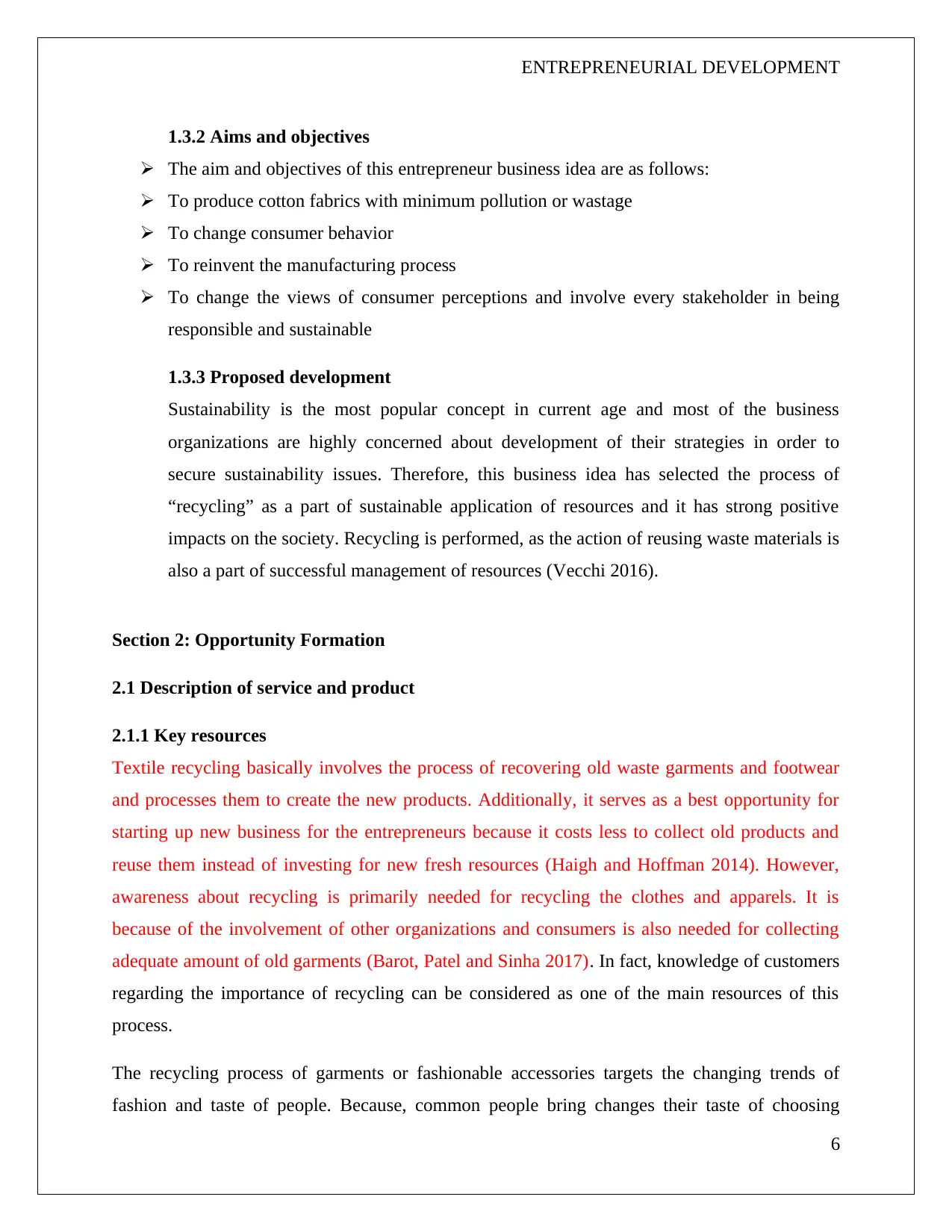
ENTREPRENEURIAL DEVELOPMENT
1.3.2 Aims and objectives
The aim and objectives of this entrepreneur business idea are as follows:
To produce cotton fabrics with minimum pollution or wastage
To change consumer behavior
To reinvent the manufacturing process
To change the views of consumer perceptions and involve every stakeholder in being
responsible and sustainable
1.3.3 Proposed development
Sustainability is the most popular concept in current age and most of the business
organizations are highly concerned about development of their strategies in order to
secure sustainability issues. Therefore, this business idea has selected the process of
“recycling” as a part of sustainable application of resources and it has strong positive
impacts on the society. Recycling is performed, as the action of reusing waste materials is
also a part of successful management of resources (Vecchi 2016).
Section 2: Opportunity Formation
2.1 Description of service and product
2.1.1 Key resources
Textile recycling basically involves the process of recovering old waste garments and footwear
and processes them to create the new products. Additionally, it serves as a best opportunity for
starting up new business for the entrepreneurs because it costs less to collect old products and
reuse them instead of investing for new fresh resources (Haigh and Hoffman 2014). However,
awareness about recycling is primarily needed for recycling the clothes and apparels. It is
because of the involvement of other organizations and consumers is also needed for collecting
adequate amount of old garments (Barot, Patel and Sinha 2017). In fact, knowledge of customers
regarding the importance of recycling can be considered as one of the main resources of this
process.
The recycling process of garments or fashionable accessories targets the changing trends of
fashion and taste of people. Because, common people bring changes their taste of choosing
6
1.3.2 Aims and objectives
The aim and objectives of this entrepreneur business idea are as follows:
To produce cotton fabrics with minimum pollution or wastage
To change consumer behavior
To reinvent the manufacturing process
To change the views of consumer perceptions and involve every stakeholder in being
responsible and sustainable
1.3.3 Proposed development
Sustainability is the most popular concept in current age and most of the business
organizations are highly concerned about development of their strategies in order to
secure sustainability issues. Therefore, this business idea has selected the process of
“recycling” as a part of sustainable application of resources and it has strong positive
impacts on the society. Recycling is performed, as the action of reusing waste materials is
also a part of successful management of resources (Vecchi 2016).
Section 2: Opportunity Formation
2.1 Description of service and product
2.1.1 Key resources
Textile recycling basically involves the process of recovering old waste garments and footwear
and processes them to create the new products. Additionally, it serves as a best opportunity for
starting up new business for the entrepreneurs because it costs less to collect old products and
reuse them instead of investing for new fresh resources (Haigh and Hoffman 2014). However,
awareness about recycling is primarily needed for recycling the clothes and apparels. It is
because of the involvement of other organizations and consumers is also needed for collecting
adequate amount of old garments (Barot, Patel and Sinha 2017). In fact, knowledge of customers
regarding the importance of recycling can be considered as one of the main resources of this
process.
The recycling process of garments or fashionable accessories targets the changing trends of
fashion and taste of people. Because, common people bring changes their taste of choosing
6
⊘ This is a preview!⊘
Do you want full access?
Subscribe today to unlock all pages.

Trusted by 1+ million students worldwide
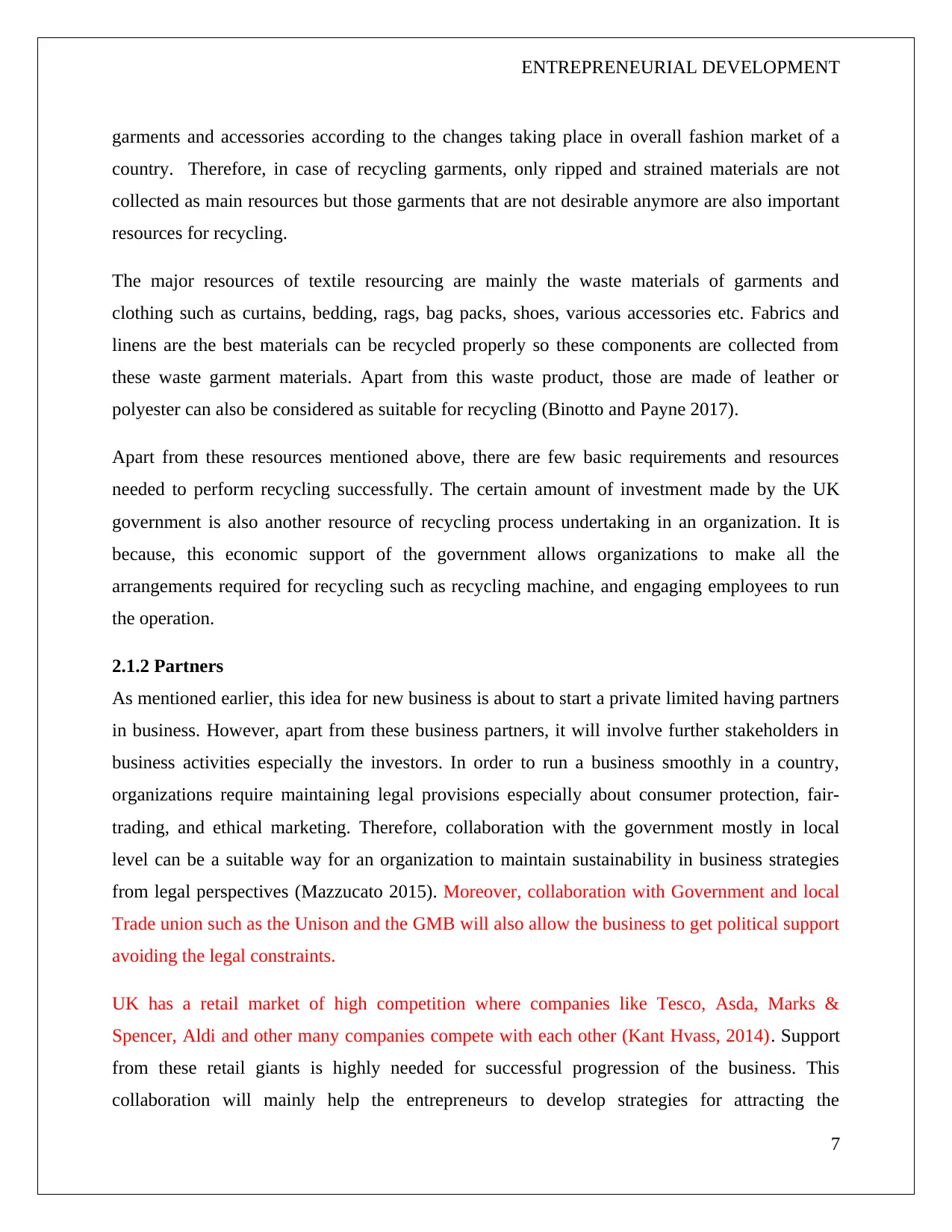
ENTREPRENEURIAL DEVELOPMENT
garments and accessories according to the changes taking place in overall fashion market of a
country. Therefore, in case of recycling garments, only ripped and strained materials are not
collected as main resources but those garments that are not desirable anymore are also important
resources for recycling.
The major resources of textile resourcing are mainly the waste materials of garments and
clothing such as curtains, bedding, rags, bag packs, shoes, various accessories etc. Fabrics and
linens are the best materials can be recycled properly so these components are collected from
these waste garment materials. Apart from this waste product, those are made of leather or
polyester can also be considered as suitable for recycling (Binotto and Payne 2017).
Apart from these resources mentioned above, there are few basic requirements and resources
needed to perform recycling successfully. The certain amount of investment made by the UK
government is also another resource of recycling process undertaking in an organization. It is
because, this economic support of the government allows organizations to make all the
arrangements required for recycling such as recycling machine, and engaging employees to run
the operation.
2.1.2 Partners
As mentioned earlier, this idea for new business is about to start a private limited having partners
in business. However, apart from these business partners, it will involve further stakeholders in
business activities especially the investors. In order to run a business smoothly in a country,
organizations require maintaining legal provisions especially about consumer protection, fair-
trading, and ethical marketing. Therefore, collaboration with the government mostly in local
level can be a suitable way for an organization to maintain sustainability in business strategies
from legal perspectives (Mazzucato 2015). Moreover, collaboration with Government and local
Trade union such as the Unison and the GMB will also allow the business to get political support
avoiding the legal constraints.
UK has a retail market of high competition where companies like Tesco, Asda, Marks &
Spencer, Aldi and other many companies compete with each other (Kant Hvass, 2014). Support
from these retail giants is highly needed for successful progression of the business. This
collaboration will mainly help the entrepreneurs to develop strategies for attracting the
7
garments and accessories according to the changes taking place in overall fashion market of a
country. Therefore, in case of recycling garments, only ripped and strained materials are not
collected as main resources but those garments that are not desirable anymore are also important
resources for recycling.
The major resources of textile resourcing are mainly the waste materials of garments and
clothing such as curtains, bedding, rags, bag packs, shoes, various accessories etc. Fabrics and
linens are the best materials can be recycled properly so these components are collected from
these waste garment materials. Apart from this waste product, those are made of leather or
polyester can also be considered as suitable for recycling (Binotto and Payne 2017).
Apart from these resources mentioned above, there are few basic requirements and resources
needed to perform recycling successfully. The certain amount of investment made by the UK
government is also another resource of recycling process undertaking in an organization. It is
because, this economic support of the government allows organizations to make all the
arrangements required for recycling such as recycling machine, and engaging employees to run
the operation.
2.1.2 Partners
As mentioned earlier, this idea for new business is about to start a private limited having partners
in business. However, apart from these business partners, it will involve further stakeholders in
business activities especially the investors. In order to run a business smoothly in a country,
organizations require maintaining legal provisions especially about consumer protection, fair-
trading, and ethical marketing. Therefore, collaboration with the government mostly in local
level can be a suitable way for an organization to maintain sustainability in business strategies
from legal perspectives (Mazzucato 2015). Moreover, collaboration with Government and local
Trade union such as the Unison and the GMB will also allow the business to get political support
avoiding the legal constraints.
UK has a retail market of high competition where companies like Tesco, Asda, Marks &
Spencer, Aldi and other many companies compete with each other (Kant Hvass, 2014). Support
from these retail giants is highly needed for successful progression of the business. This
collaboration will mainly help the entrepreneurs to develop strategies for attracting the
7
Paraphrase This Document
Need a fresh take? Get an instant paraphrase of this document with our AI Paraphraser
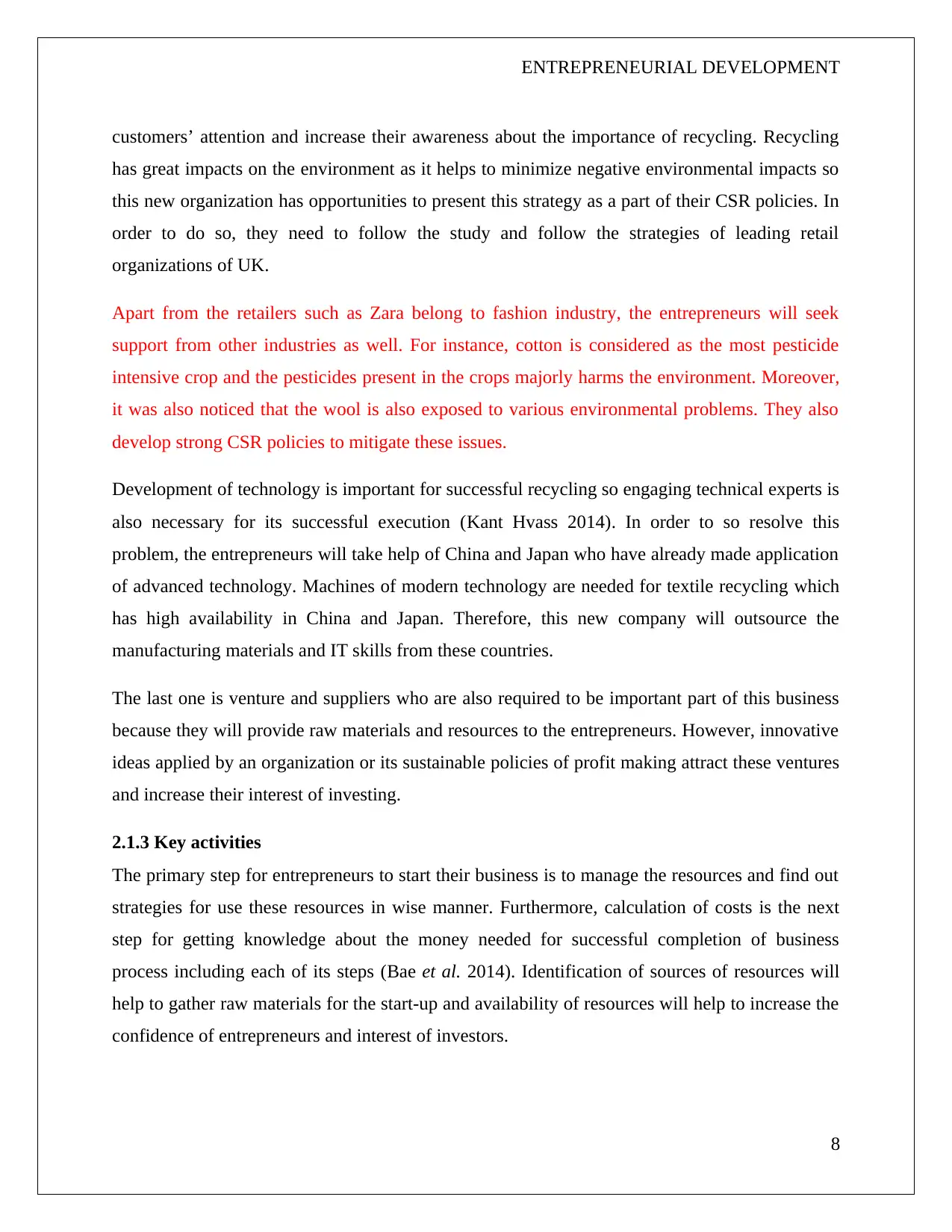
ENTREPRENEURIAL DEVELOPMENT
customers’ attention and increase their awareness about the importance of recycling. Recycling
has great impacts on the environment as it helps to minimize negative environmental impacts so
this new organization has opportunities to present this strategy as a part of their CSR policies. In
order to do so, they need to follow the study and follow the strategies of leading retail
organizations of UK.
Apart from the retailers such as Zara belong to fashion industry, the entrepreneurs will seek
support from other industries as well. For instance, cotton is considered as the most pesticide
intensive crop and the pesticides present in the crops majorly harms the environment. Moreover,
it was also noticed that the wool is also exposed to various environmental problems. They also
develop strong CSR policies to mitigate these issues.
Development of technology is important for successful recycling so engaging technical experts is
also necessary for its successful execution (Kant Hvass 2014). In order to so resolve this
problem, the entrepreneurs will take help of China and Japan who have already made application
of advanced technology. Machines of modern technology are needed for textile recycling which
has high availability in China and Japan. Therefore, this new company will outsource the
manufacturing materials and IT skills from these countries.
The last one is venture and suppliers who are also required to be important part of this business
because they will provide raw materials and resources to the entrepreneurs. However, innovative
ideas applied by an organization or its sustainable policies of profit making attract these ventures
and increase their interest of investing.
2.1.3 Key activities
The primary step for entrepreneurs to start their business is to manage the resources and find out
strategies for use these resources in wise manner. Furthermore, calculation of costs is the next
step for getting knowledge about the money needed for successful completion of business
process including each of its steps (Bae et al. 2014). Identification of sources of resources will
help to gather raw materials for the start-up and availability of resources will help to increase the
confidence of entrepreneurs and interest of investors.
8
customers’ attention and increase their awareness about the importance of recycling. Recycling
has great impacts on the environment as it helps to minimize negative environmental impacts so
this new organization has opportunities to present this strategy as a part of their CSR policies. In
order to do so, they need to follow the study and follow the strategies of leading retail
organizations of UK.
Apart from the retailers such as Zara belong to fashion industry, the entrepreneurs will seek
support from other industries as well. For instance, cotton is considered as the most pesticide
intensive crop and the pesticides present in the crops majorly harms the environment. Moreover,
it was also noticed that the wool is also exposed to various environmental problems. They also
develop strong CSR policies to mitigate these issues.
Development of technology is important for successful recycling so engaging technical experts is
also necessary for its successful execution (Kant Hvass 2014). In order to so resolve this
problem, the entrepreneurs will take help of China and Japan who have already made application
of advanced technology. Machines of modern technology are needed for textile recycling which
has high availability in China and Japan. Therefore, this new company will outsource the
manufacturing materials and IT skills from these countries.
The last one is venture and suppliers who are also required to be important part of this business
because they will provide raw materials and resources to the entrepreneurs. However, innovative
ideas applied by an organization or its sustainable policies of profit making attract these ventures
and increase their interest of investing.
2.1.3 Key activities
The primary step for entrepreneurs to start their business is to manage the resources and find out
strategies for use these resources in wise manner. Furthermore, calculation of costs is the next
step for getting knowledge about the money needed for successful completion of business
process including each of its steps (Bae et al. 2014). Identification of sources of resources will
help to gather raw materials for the start-up and availability of resources will help to increase the
confidence of entrepreneurs and interest of investors.
8
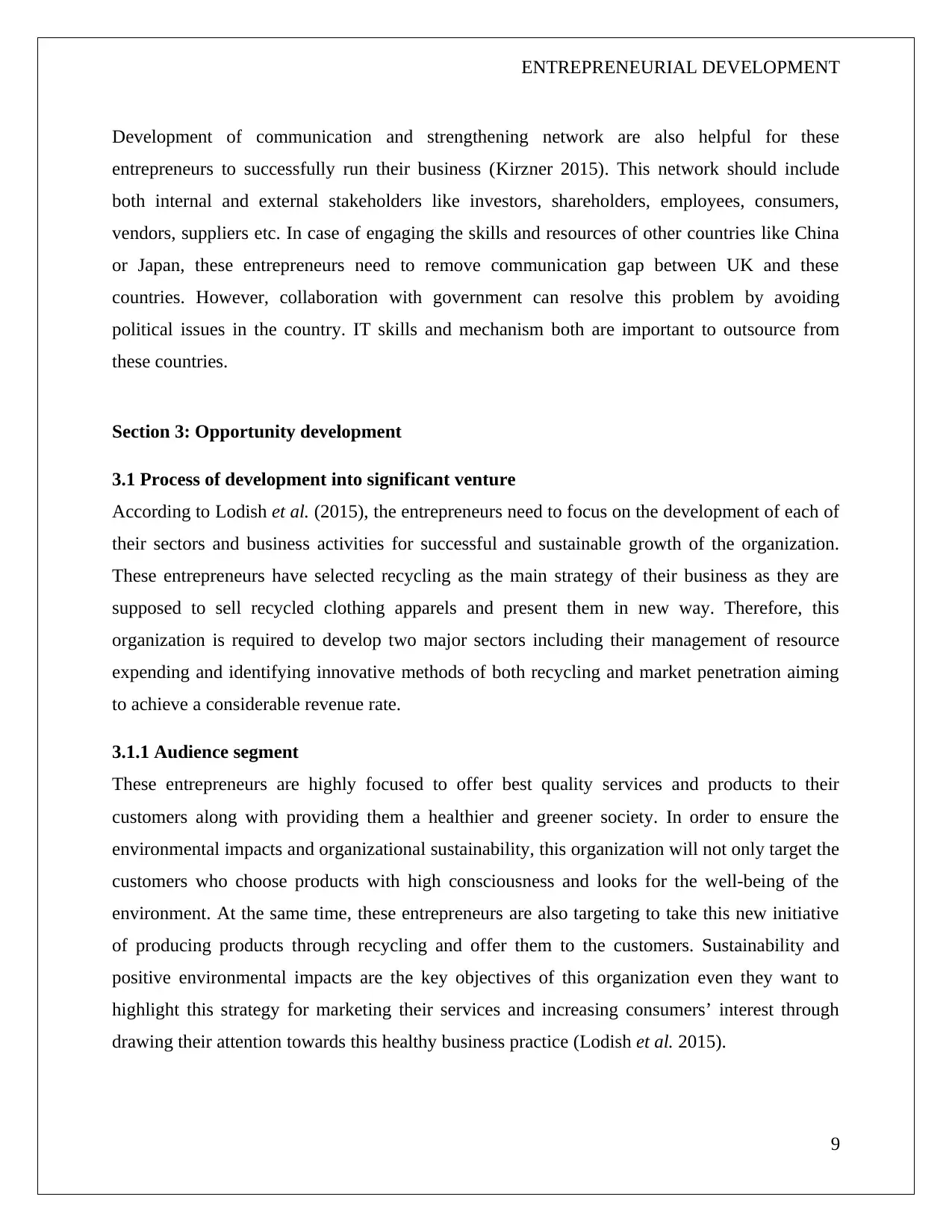
ENTREPRENEURIAL DEVELOPMENT
Development of communication and strengthening network are also helpful for these
entrepreneurs to successfully run their business (Kirzner 2015). This network should include
both internal and external stakeholders like investors, shareholders, employees, consumers,
vendors, suppliers etc. In case of engaging the skills and resources of other countries like China
or Japan, these entrepreneurs need to remove communication gap between UK and these
countries. However, collaboration with government can resolve this problem by avoiding
political issues in the country. IT skills and mechanism both are important to outsource from
these countries.
Section 3: Opportunity development
3.1 Process of development into significant venture
According to Lodish et al. (2015), the entrepreneurs need to focus on the development of each of
their sectors and business activities for successful and sustainable growth of the organization.
These entrepreneurs have selected recycling as the main strategy of their business as they are
supposed to sell recycled clothing apparels and present them in new way. Therefore, this
organization is required to develop two major sectors including their management of resource
expending and identifying innovative methods of both recycling and market penetration aiming
to achieve a considerable revenue rate.
3.1.1 Audience segment
These entrepreneurs are highly focused to offer best quality services and products to their
customers along with providing them a healthier and greener society. In order to ensure the
environmental impacts and organizational sustainability, this organization will not only target the
customers who choose products with high consciousness and looks for the well-being of the
environment. At the same time, these entrepreneurs are also targeting to take this new initiative
of producing products through recycling and offer them to the customers. Sustainability and
positive environmental impacts are the key objectives of this organization even they want to
highlight this strategy for marketing their services and increasing consumers’ interest through
drawing their attention towards this healthy business practice (Lodish et al. 2015).
9
Development of communication and strengthening network are also helpful for these
entrepreneurs to successfully run their business (Kirzner 2015). This network should include
both internal and external stakeholders like investors, shareholders, employees, consumers,
vendors, suppliers etc. In case of engaging the skills and resources of other countries like China
or Japan, these entrepreneurs need to remove communication gap between UK and these
countries. However, collaboration with government can resolve this problem by avoiding
political issues in the country. IT skills and mechanism both are important to outsource from
these countries.
Section 3: Opportunity development
3.1 Process of development into significant venture
According to Lodish et al. (2015), the entrepreneurs need to focus on the development of each of
their sectors and business activities for successful and sustainable growth of the organization.
These entrepreneurs have selected recycling as the main strategy of their business as they are
supposed to sell recycled clothing apparels and present them in new way. Therefore, this
organization is required to develop two major sectors including their management of resource
expending and identifying innovative methods of both recycling and market penetration aiming
to achieve a considerable revenue rate.
3.1.1 Audience segment
These entrepreneurs are highly focused to offer best quality services and products to their
customers along with providing them a healthier and greener society. In order to ensure the
environmental impacts and organizational sustainability, this organization will not only target the
customers who choose products with high consciousness and looks for the well-being of the
environment. At the same time, these entrepreneurs are also targeting to take this new initiative
of producing products through recycling and offer them to the customers. Sustainability and
positive environmental impacts are the key objectives of this organization even they want to
highlight this strategy for marketing their services and increasing consumers’ interest through
drawing their attention towards this healthy business practice (Lodish et al. 2015).
9
⊘ This is a preview!⊘
Do you want full access?
Subscribe today to unlock all pages.

Trusted by 1+ million students worldwide
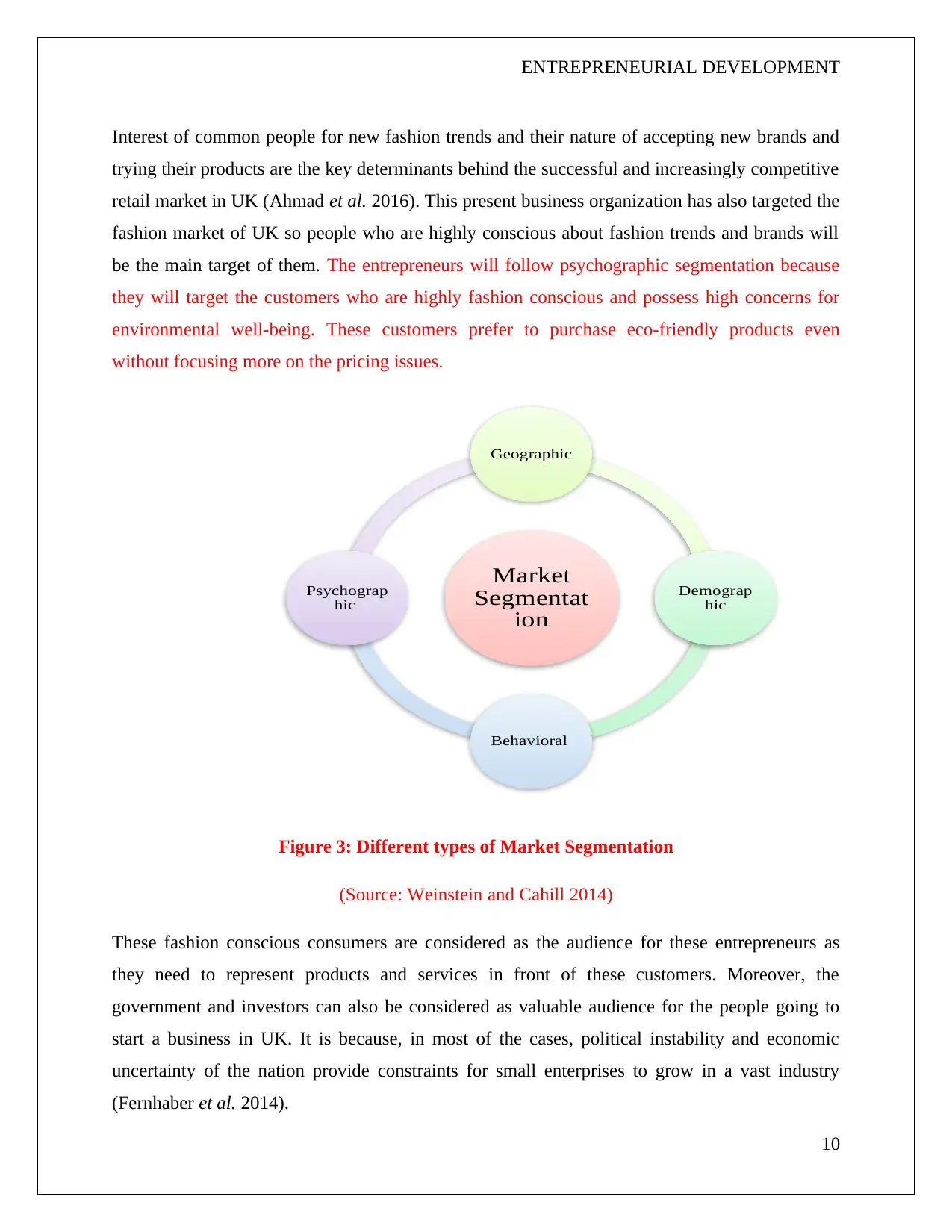
ENTREPRENEURIAL DEVELOPMENT
Interest of common people for new fashion trends and their nature of accepting new brands and
trying their products are the key determinants behind the successful and increasingly competitive
retail market in UK (Ahmad et al. 2016). This present business organization has also targeted the
fashion market of UK so people who are highly conscious about fashion trends and brands will
be the main target of them. The entrepreneurs will follow psychographic segmentation because
they will target the customers who are highly fashion conscious and possess high concerns for
environmental well-being. These customers prefer to purchase eco-friendly products even
without focusing more on the pricing issues.
Figure 3: Different types of Market Segmentation
(Source: Weinstein and Cahill 2014)
These fashion conscious consumers are considered as the audience for these entrepreneurs as
they need to represent products and services in front of these customers. Moreover, the
government and investors can also be considered as valuable audience for the people going to
start a business in UK. It is because, in most of the cases, political instability and economic
uncertainty of the nation provide constraints for small enterprises to grow in a vast industry
(Fernhaber et al. 2014).
10
Market
Segmentat
ion
Geographic
Demograp
hic
Behavioral
Psychograp
hic
Interest of common people for new fashion trends and their nature of accepting new brands and
trying their products are the key determinants behind the successful and increasingly competitive
retail market in UK (Ahmad et al. 2016). This present business organization has also targeted the
fashion market of UK so people who are highly conscious about fashion trends and brands will
be the main target of them. The entrepreneurs will follow psychographic segmentation because
they will target the customers who are highly fashion conscious and possess high concerns for
environmental well-being. These customers prefer to purchase eco-friendly products even
without focusing more on the pricing issues.
Figure 3: Different types of Market Segmentation
(Source: Weinstein and Cahill 2014)
These fashion conscious consumers are considered as the audience for these entrepreneurs as
they need to represent products and services in front of these customers. Moreover, the
government and investors can also be considered as valuable audience for the people going to
start a business in UK. It is because, in most of the cases, political instability and economic
uncertainty of the nation provide constraints for small enterprises to grow in a vast industry
(Fernhaber et al. 2014).
10
Market
Segmentat
ion
Geographic
Demograp
hic
Behavioral
Psychograp
hic
Paraphrase This Document
Need a fresh take? Get an instant paraphrase of this document with our AI Paraphraser
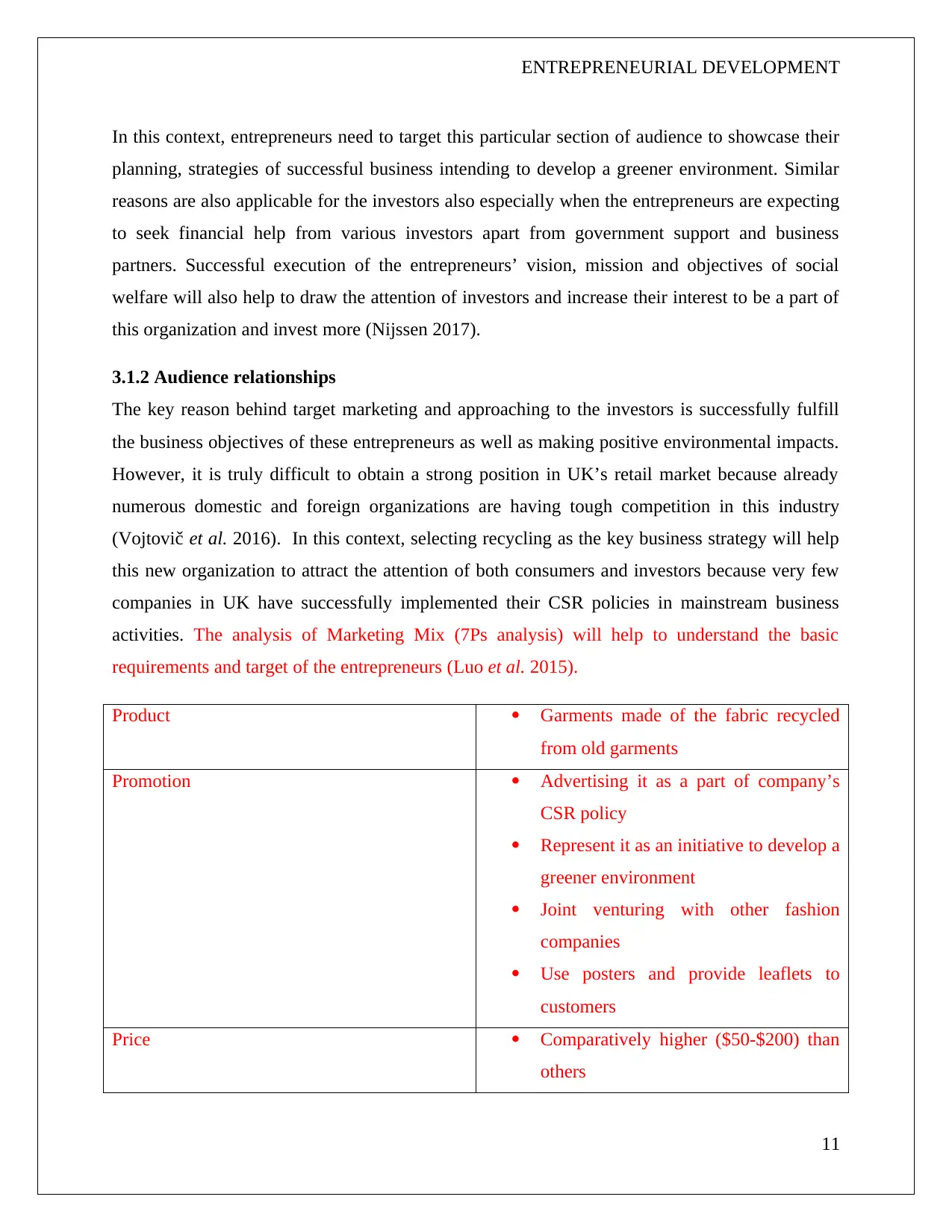
ENTREPRENEURIAL DEVELOPMENT
In this context, entrepreneurs need to target this particular section of audience to showcase their
planning, strategies of successful business intending to develop a greener environment. Similar
reasons are also applicable for the investors also especially when the entrepreneurs are expecting
to seek financial help from various investors apart from government support and business
partners. Successful execution of the entrepreneurs’ vision, mission and objectives of social
welfare will also help to draw the attention of investors and increase their interest to be a part of
this organization and invest more (Nijssen 2017).
3.1.2 Audience relationships
The key reason behind target marketing and approaching to the investors is successfully fulfill
the business objectives of these entrepreneurs as well as making positive environmental impacts.
However, it is truly difficult to obtain a strong position in UK’s retail market because already
numerous domestic and foreign organizations are having tough competition in this industry
(Vojtovič et al. 2016). In this context, selecting recycling as the key business strategy will help
this new organization to attract the attention of both consumers and investors because very few
companies in UK have successfully implemented their CSR policies in mainstream business
activities. The analysis of Marketing Mix (7Ps analysis) will help to understand the basic
requirements and target of the entrepreneurs (Luo et al. 2015).
Product Garments made of the fabric recycled
from old garments
Promotion Advertising it as a part of company’s
CSR policy
Represent it as an initiative to develop a
greener environment
Joint venturing with other fashion
companies
Use posters and provide leaflets to
customers
Price Comparatively higher ($50-$200) than
others
11
In this context, entrepreneurs need to target this particular section of audience to showcase their
planning, strategies of successful business intending to develop a greener environment. Similar
reasons are also applicable for the investors also especially when the entrepreneurs are expecting
to seek financial help from various investors apart from government support and business
partners. Successful execution of the entrepreneurs’ vision, mission and objectives of social
welfare will also help to draw the attention of investors and increase their interest to be a part of
this organization and invest more (Nijssen 2017).
3.1.2 Audience relationships
The key reason behind target marketing and approaching to the investors is successfully fulfill
the business objectives of these entrepreneurs as well as making positive environmental impacts.
However, it is truly difficult to obtain a strong position in UK’s retail market because already
numerous domestic and foreign organizations are having tough competition in this industry
(Vojtovič et al. 2016). In this context, selecting recycling as the key business strategy will help
this new organization to attract the attention of both consumers and investors because very few
companies in UK have successfully implemented their CSR policies in mainstream business
activities. The analysis of Marketing Mix (7Ps analysis) will help to understand the basic
requirements and target of the entrepreneurs (Luo et al. 2015).
Product Garments made of the fabric recycled
from old garments
Promotion Advertising it as a part of company’s
CSR policy
Represent it as an initiative to develop a
greener environment
Joint venturing with other fashion
companies
Use posters and provide leaflets to
customers
Price Comparatively higher ($50-$200) than
others
11
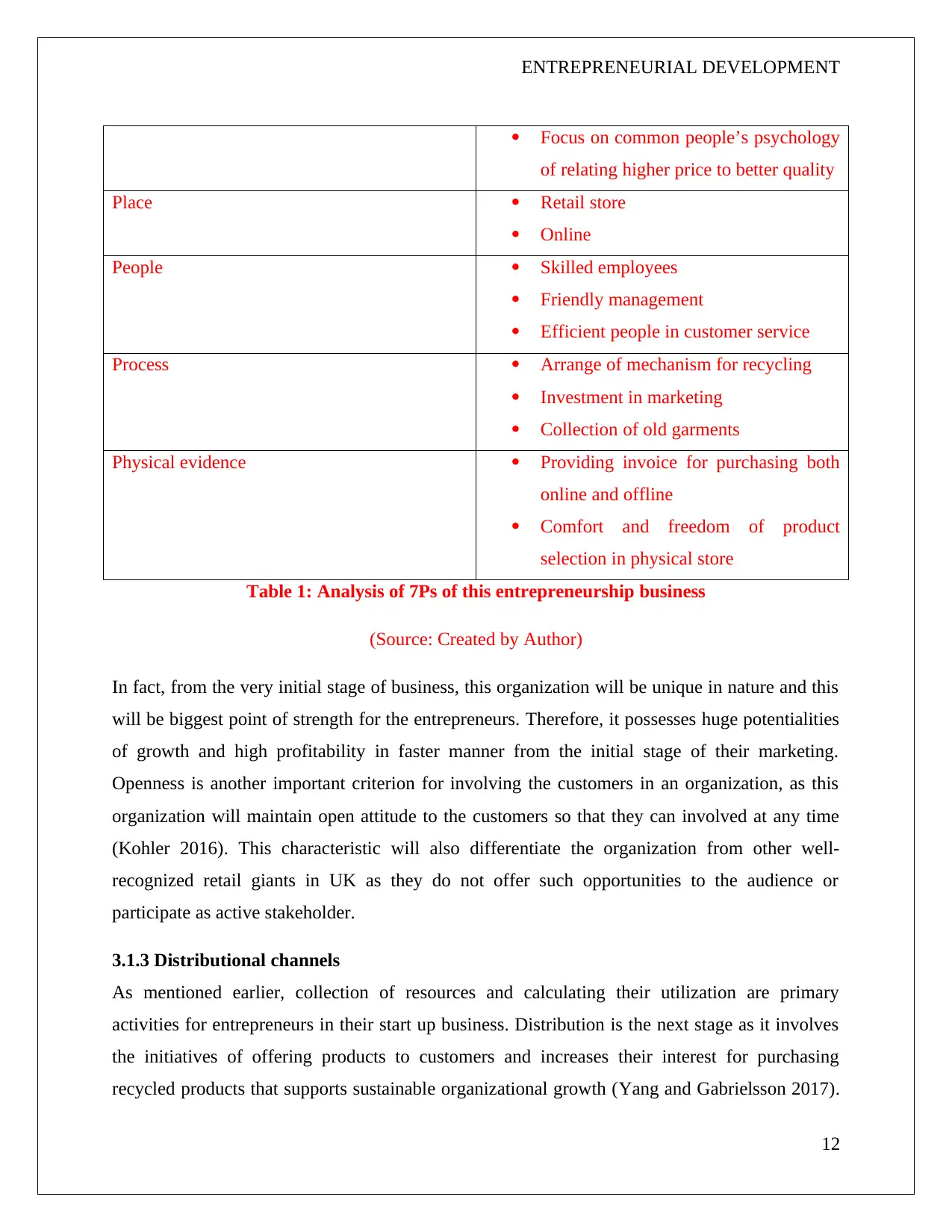
ENTREPRENEURIAL DEVELOPMENT
Focus on common people’s psychology
of relating higher price to better quality
Place Retail store
Online
People Skilled employees
Friendly management
Efficient people in customer service
Process Arrange of mechanism for recycling
Investment in marketing
Collection of old garments
Physical evidence Providing invoice for purchasing both
online and offline
Comfort and freedom of product
selection in physical store
Table 1: Analysis of 7Ps of this entrepreneurship business
(Source: Created by Author)
In fact, from the very initial stage of business, this organization will be unique in nature and this
will be biggest point of strength for the entrepreneurs. Therefore, it possesses huge potentialities
of growth and high profitability in faster manner from the initial stage of their marketing.
Openness is another important criterion for involving the customers in an organization, as this
organization will maintain open attitude to the customers so that they can involved at any time
(Kohler 2016). This characteristic will also differentiate the organization from other well-
recognized retail giants in UK as they do not offer such opportunities to the audience or
participate as active stakeholder.
3.1.3 Distributional channels
As mentioned earlier, collection of resources and calculating their utilization are primary
activities for entrepreneurs in their start up business. Distribution is the next stage as it involves
the initiatives of offering products to customers and increases their interest for purchasing
recycled products that supports sustainable organizational growth (Yang and Gabrielsson 2017).
12
Focus on common people’s psychology
of relating higher price to better quality
Place Retail store
Online
People Skilled employees
Friendly management
Efficient people in customer service
Process Arrange of mechanism for recycling
Investment in marketing
Collection of old garments
Physical evidence Providing invoice for purchasing both
online and offline
Comfort and freedom of product
selection in physical store
Table 1: Analysis of 7Ps of this entrepreneurship business
(Source: Created by Author)
In fact, from the very initial stage of business, this organization will be unique in nature and this
will be biggest point of strength for the entrepreneurs. Therefore, it possesses huge potentialities
of growth and high profitability in faster manner from the initial stage of their marketing.
Openness is another important criterion for involving the customers in an organization, as this
organization will maintain open attitude to the customers so that they can involved at any time
(Kohler 2016). This characteristic will also differentiate the organization from other well-
recognized retail giants in UK as they do not offer such opportunities to the audience or
participate as active stakeholder.
3.1.3 Distributional channels
As mentioned earlier, collection of resources and calculating their utilization are primary
activities for entrepreneurs in their start up business. Distribution is the next stage as it involves
the initiatives of offering products to customers and increases their interest for purchasing
recycled products that supports sustainable organizational growth (Yang and Gabrielsson 2017).
12
⊘ This is a preview!⊘
Do you want full access?
Subscribe today to unlock all pages.

Trusted by 1+ million students worldwide
1 out of 22
Related Documents
Your All-in-One AI-Powered Toolkit for Academic Success.
+13062052269
info@desklib.com
Available 24*7 on WhatsApp / Email
![[object Object]](/_next/static/media/star-bottom.7253800d.svg)
Unlock your academic potential
Copyright © 2020–2025 A2Z Services. All Rights Reserved. Developed and managed by ZUCOL.




